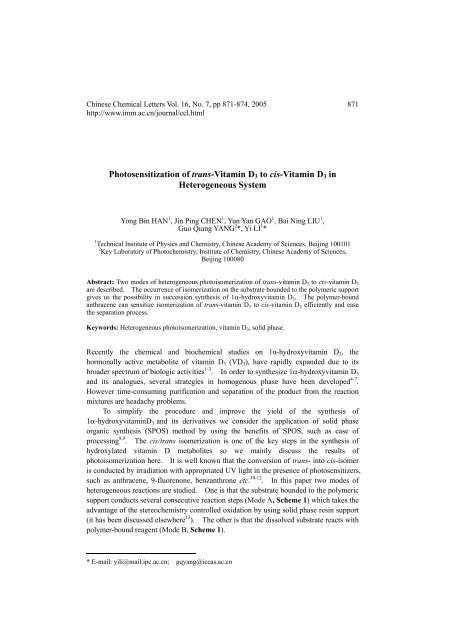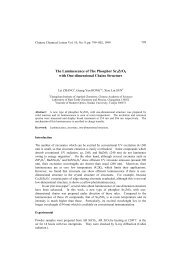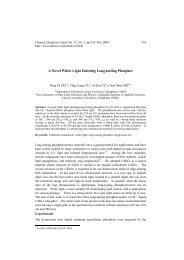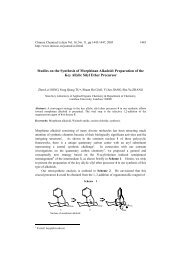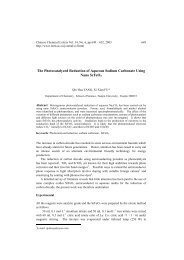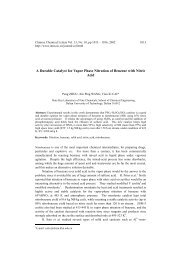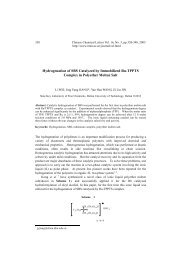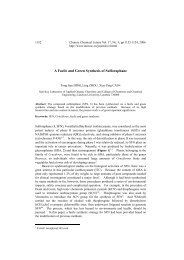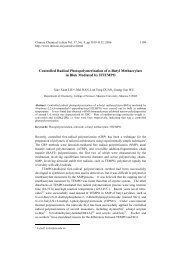Photosensitization of trans-Vitamin D3 to cis-Vitamin D3 in Heterogeneous System
Photosensitization of trans-Vitamin D3 to cis-Vitamin D3 in Heterogeneous System
Photosensitization of trans-Vitamin D3 to cis-Vitamin D3 in Heterogeneous System
Create successful ePaper yourself
Turn your PDF publications into a flip-book with our unique Google optimized e-Paper software.
Ch<strong>in</strong>ese Chemical Letters Vol. 16, No. 7, pp 871-874, 2005<br />
http://www.imm.ac.cn/journal/ccl.html<br />
<strong>Pho<strong>to</strong>sensitization</strong> <strong>of</strong> <strong>trans</strong>-<strong>Vitam<strong>in</strong></strong> <strong>D3</strong> <strong>to</strong> <strong>cis</strong>-<strong>Vitam<strong>in</strong></strong> <strong>D3</strong> <strong>in</strong><br />
<strong>Heterogeneous</strong> <strong>System</strong><br />
Yong B<strong>in</strong> HAN 1 , J<strong>in</strong> P<strong>in</strong>g CHEN 1 , Yun Yan GAO 1 , Bai N<strong>in</strong>g LIU 1 ,<br />
Guo Qiang YANG 2 *, Yi LI 1 *<br />
1 Technical Institute <strong>of</strong> Physics and Chemistry, Ch<strong>in</strong>ese Academy <strong>of</strong> Sciences, Beij<strong>in</strong>g 100101<br />
2 Key Labora<strong>to</strong>ry <strong>of</strong> Pho<strong>to</strong>chemistry, Institute <strong>of</strong> Chemistry, Ch<strong>in</strong>ese Academy <strong>of</strong> Sciences,<br />
Beij<strong>in</strong>g 100080<br />
Abstract: Two modes <strong>of</strong> heterogeneous pho<strong>to</strong>isomerization <strong>of</strong> <strong>trans</strong>-vitam<strong>in</strong> D 3 <strong>to</strong> <strong>cis</strong>-vitam<strong>in</strong> D 3<br />
are described. The occurrence <strong>of</strong> isomerization on the substrate bounded <strong>to</strong> the polymeric support<br />
gives us the possibility <strong>in</strong> succession synthesis <strong>of</strong> 1α-hydroxyvitam<strong>in</strong> D 3. The polymer-bound<br />
anthracene can sensitize isomerization <strong>of</strong> <strong>trans</strong>-vitam<strong>in</strong> D 3 <strong>to</strong> <strong>cis</strong>-vitam<strong>in</strong> D 3 efficiently and ease<br />
the separation process.<br />
Keywords: <strong>Heterogeneous</strong> pho<strong>to</strong>isomerization, vitam<strong>in</strong> D 3, solid phase.<br />
Recently the chemical and biochemical studies on 1α-hydroxyvitam<strong>in</strong> <strong>D3</strong>, the<br />
hormonally active metabolite <strong>of</strong> vitam<strong>in</strong> <strong>D3</strong> (V<strong>D3</strong>), have rapidly expanded due <strong>to</strong> its<br />
broader spectrum <strong>of</strong> biologic activities 1-3 . In order <strong>to</strong> synthesize 1α-hydroxyvitam<strong>in</strong> <strong>D3</strong><br />
and its analogues, several strategies <strong>in</strong> homogenous phase have been developed 4-7 .<br />
However time-consum<strong>in</strong>g purification and separation <strong>of</strong> the product from the reaction<br />
mixtures are headachy problems.<br />
To simplify the procedure and improve the yield <strong>of</strong> the synthesis <strong>of</strong><br />
1α-hydroxyvitam<strong>in</strong><strong>D3</strong> and its derivatives we consider the application <strong>of</strong> solid phase<br />
organic synthesis (SPOS) method by us<strong>in</strong>g the benefits <strong>of</strong> SPOS, such as ease <strong>of</strong><br />
process<strong>in</strong>g 8,9 . The <strong>cis</strong>/<strong>trans</strong> isomerization is one <strong>of</strong> the key steps <strong>in</strong> the synthesis <strong>of</strong><br />
hydroxylated vitam<strong>in</strong> D metabolites so we ma<strong>in</strong>ly discuss the results <strong>of</strong><br />
pho<strong>to</strong>isomerization here. It is well known that the conversion <strong>of</strong> <strong>trans</strong>- <strong>in</strong><strong>to</strong> <strong>cis</strong>-isomer<br />
is conducted by irradiation with appropriated UV light <strong>in</strong> the presence <strong>of</strong> pho<strong>to</strong>sensitizers,<br />
such as anthracene, 9-fluorenone, benzanthrone etc. 10-12 . In this paper two modes <strong>of</strong><br />
heterogeneous reactions are studied. One is that the substrate bounded <strong>to</strong> the polymeric<br />
support conducts several consecutive reaction steps (Mode A, Scheme 1) which takes the<br />
advantage <strong>of</strong> the stereochemistry controlled oxidation by us<strong>in</strong>g solid phase res<strong>in</strong> support<br />
(it has been discussed elsewhere 13 ). The other is that the dissolved substrate reacts with<br />
polymer-bound reagent (Mode B, Scheme 1).<br />
* E-mail: yili@mail.ipc.ac.cn; gqyang@iccas.ac.cn<br />
871
872<br />
H [O] H<br />
HO<br />
HO<br />
<strong>trans</strong><br />
Yong B<strong>in</strong> HAN et al.<br />
H<br />
OH<br />
<strong>trans</strong><br />
Scheme 1<br />
hν,<br />
hν,<br />
mode A<br />
mode B<br />
OOCCH 3<br />
O<br />
HO<br />
HO<br />
<strong>cis</strong><br />
H<br />
H<br />
OH<br />
<strong>cis</strong><br />
Scheme 2 Preparation <strong>of</strong> polymer bound <strong>trans</strong>-VD 3<br />
i, ii<br />
Si Cl<br />
(i) n BuLi, TMEDA, cyclohexane, 60 o C, 12h; (ii) diphenyldichlorosilane, benzene, rt., overnight;<br />
(iii) imidazole, CH 2Cl 2, rt., overnight<br />
DMF/NaH, 80 o C, 48h<br />
Experimental<br />
Polystyene<br />
Scheme 3 Preparation <strong>of</strong> polymer bound sensitizer<br />
Cl<br />
+<br />
Merrifield res<strong>in</strong><br />
OH<br />
The procedures for preparation <strong>of</strong> polymer bound <strong>trans</strong>-V<strong>D3</strong> and polymer bound<br />
sensitizer are showed <strong>in</strong> Scheme 2 14 and Scheme 3 15 respectively. The pho<strong>to</strong>chemical<br />
reactions were carried out by us<strong>in</strong>g a 450W medium pressure Hanovia lamp <strong>in</strong> a<br />
water-cooled quartz immersion well. All the samples were <strong>in</strong> glass reac<strong>to</strong>rs <strong>to</strong> cut <strong>of</strong>f<br />
the wavelength below 300 nm and were bubbled with argon prior <strong>to</strong> and dur<strong>in</strong>g<br />
irradiation.<br />
iii<br />
H<br />
O<br />
Si<br />
O
Results and Discussion<br />
<strong>Pho<strong>to</strong>sensitization</strong> <strong>of</strong> <strong>trans</strong>-<strong>Vitam<strong>in</strong></strong> <strong>D3</strong> <strong>to</strong> <strong>cis</strong>-<strong>Vitam<strong>in</strong></strong> <strong>D3</strong><br />
The preparation <strong>of</strong> polymer bound sensitizer was described <strong>in</strong> the experimental section.<br />
The active silyl chloride content <strong>of</strong> the polymer was determ<strong>in</strong>ed by hydrolysis followed<br />
by acid-base titration <strong>to</strong> be 8.2×10 -4 mol/g res<strong>in</strong>. The amount <strong>of</strong> the sensitizer <strong>in</strong> the<br />
Merrifield res<strong>in</strong> backbone was determ<strong>in</strong>ed by UV absorption <strong>in</strong>tensity <strong>of</strong> the<br />
9-anthracene derivative which was cleaved by Schaap’s 16 cleavage procedure with<br />
SnCl4 15 as cleav<strong>in</strong>g agent. The load<strong>in</strong>g was found <strong>to</strong> be 2.0×10 -5 mol/g. The samples<br />
were taken dur<strong>in</strong>g the reaction and cleaved by us<strong>in</strong>g tetrabutylammonium fluoride<br />
(TBAF) as cleav<strong>in</strong>g agent for mode A. The amounts <strong>of</strong> <strong>cis</strong>-V<strong>D3</strong> were analyzed by<br />
HPLC.<br />
Figure 1 shows the change <strong>of</strong> concentration <strong>of</strong> <strong>cis</strong>-V<strong>D3</strong> dur<strong>in</strong>g irradiation by mode<br />
A and mode B. In mode A, after 40 m<strong>in</strong> irradiation the yield <strong>of</strong> <strong>cis</strong>-V<strong>D3</strong> was 40% and<br />
no obvious <strong>in</strong>crease by prolong<strong>in</strong>g the reaction time. On the other hand, about 85%<br />
<strong>trans</strong>-V<strong>D3</strong> was converted <strong>in</strong><strong>to</strong> <strong>cis</strong>-V<strong>D3</strong> <strong>in</strong> alcohol and 67% <strong>in</strong> <strong>to</strong>luene after 20m<strong>in</strong><br />
irradiation for mode B. The formation <strong>of</strong> <strong>cis</strong>-V<strong>D3</strong> was almost 100% based on the<br />
consumption <strong>of</strong> <strong>trans</strong>-V<strong>D3</strong>. The efficiency <strong>of</strong> mode A is much lower than that <strong>of</strong> mode<br />
B. This result can be expla<strong>in</strong>ed by light scatter<strong>in</strong>g <strong>of</strong> the res<strong>in</strong> because a relative large<br />
amount <strong>of</strong> the res<strong>in</strong> was used <strong>in</strong> mode A than mode B and the yield <strong>of</strong> <strong>cis</strong>-V<strong>D3</strong> can be<br />
<strong>in</strong>creased when large amount <strong>of</strong> the solvent is used. The other reason for this could be<br />
that <strong>trans</strong>-V<strong>D3</strong> was wrapped by res<strong>in</strong> and part <strong>of</strong> them could not absorb light.<br />
The pho<strong>to</strong>isomerizations through mode A with different amount <strong>of</strong> sensitizer were<br />
also <strong>in</strong>vestigated. To avoid over irradiation, the reaction time was fixed at 20 m<strong>in</strong>utes.<br />
The results are shown <strong>in</strong> Table 1. As expected, the reaction is faster when higher<br />
concentration sensitizer is used with<strong>in</strong> our experiment scale. The similar tendency can<br />
be observed <strong>in</strong> mode B.<br />
Furthermore, the recycle property <strong>of</strong> polymer-bound sensitizer was <strong>in</strong>vestigated and<br />
the results are shown <strong>in</strong> Table 2. After three cycles the sensitizer still shows reasonable<br />
sensitization efficiency.<br />
<strong>cis</strong>-VD 3 /%<br />
Figure 1 The change <strong>of</strong> the concentration <strong>of</strong> <strong>cis</strong>-VD 3 as a function <strong>of</strong> irradiation time<br />
40<br />
30<br />
20<br />
10<br />
0<br />
Mode A Mode B<br />
0 10 20 30 40 50 60<br />
irradiation time/m<strong>in</strong><br />
0 5 10 15 20<br />
irradiation time/m<strong>in</strong><br />
In <strong>to</strong>luene and concentration <strong>of</strong> sensitizer: Concentration <strong>of</strong> sensitizer moiety: 4×10 -5<br />
0.10 mol/L; <strong>in</strong>itial concentration <strong>of</strong> <strong>trans</strong>- mol/L; <strong>in</strong>itial concentration <strong>of</strong> <strong>trans</strong>-VD 3:<br />
V<strong>D3</strong> moiety: 1.2×10 -2 mol/L 8.0×10 -4 mol/L<br />
<strong>cis</strong>-VD 3 /%<br />
100<br />
80<br />
60<br />
40<br />
20<br />
0<br />
<strong>in</strong> alcohol<br />
<strong>in</strong> <strong>to</strong>luene<br />
873
874<br />
Yong B<strong>in</strong> HAN et al.<br />
Table 1 The yield <strong>of</strong> <strong>cis</strong>-VD 3 <strong>in</strong> <strong>to</strong>luene with different concentration <strong>of</strong> sensitizer after 20 m<strong>in</strong><br />
irradiation with mode A<br />
Concentration <strong>of</strong> sensitizer/(mol/L) 0.02 0.04 0.06 0.08 0.10<br />
<strong>cis</strong>-VD 3/% 12.5 16.1 20.3 31.0 35.5<br />
<strong>in</strong>itial concentration <strong>of</strong> <strong>trans</strong>-VD 3 moiety: 1.2×10 -2 mol/L.<br />
Table 2 Recycle results <strong>of</strong> the polymer-bound sensitizer<br />
Cycle <strong>cis</strong>-VD 3/%<br />
1 88.0<br />
2 87.8<br />
3 80.2<br />
8.0×10 -5 mol/L polymer-bound sensitizer, 8×10 -4 mol/L <strong>trans</strong>-VD 3 <strong>in</strong> alcohol.<br />
Conclusion<br />
The results presented <strong>in</strong> this paper <strong>in</strong>dicate that the polymer-bound anthracene can<br />
sensitize <strong>trans</strong>-V<strong>D3</strong> <strong>to</strong> isomerize <strong>to</strong> <strong>cis</strong>-V<strong>D3</strong> efficiently and this heterogeneous pho<strong>to</strong>-<br />
sensitizer may be feasible <strong>to</strong> the <strong>in</strong>dustrial production because <strong>of</strong> its easy separation from<br />
the reaction mixture. The occurrence <strong>of</strong> isomerization on the substrate bounded <strong>to</strong> the<br />
polymeric support shows us the possibility <strong>in</strong> succession synthesis <strong>of</strong> 1α-hydroxy-<br />
vitam<strong>in</strong> <strong>D3</strong> by us<strong>in</strong>g SPOS.<br />
Acknowledgment<br />
This work was supported by the Major State Basic Research Development Program, Grant No.<br />
G2000078100, the National Natural Science Foundation <strong>of</strong> Ch<strong>in</strong>a, No. 20172059 and Ch<strong>in</strong>ese<br />
Academy <strong>of</strong> Sciences.<br />
References<br />
1. A. Brehier, M. Thomasset, J. Steroid Biochem., 1988, 29, 265.<br />
2. M. F. Holick, E. J. Semmler, H. K. Schnose, H. F. Deluca, Science, 1973, 180, 190.<br />
3. D. Feldman, F. H. Glorieux, J. W. Pike, <strong>Vitam<strong>in</strong></strong> D, Academic Press, San Diego, 1997.<br />
4. G. D. Zhu, W. H. Okamura, Chem. Rev., 1995, 95, 1877.<br />
5. D. R. Andrews, D. H. R. Bar<strong>to</strong>n, K. P. Cheng, et al., J. Org. Chem., 1986, 51, 1635.<br />
6. W. Reischl, H. Kalchhauser, Tetrahedron Lett., 1992, 33, 2451.<br />
7. H. E. Paaren, H. F. Deluca, H. K. Schnoes, J. Org. Chem., 1980, 45, 3253.<br />
8. R. B. Merrifield, J. Am. Chem. Soc., 1963, 85, 2149.<br />
9. A. W. Czarnik, Solid-Phase Organic Synthesis, John Wiley, New York, 2001.<br />
10. J. W. J. Gielen, R. B. Koolstra, H. J. C. Jacobs, E. Hav<strong>in</strong>ga, Recl. Trav. Chim. Pays-Bas J. Rol.<br />
Netherlands Chem. Soc., 1980, 99, 306.<br />
11. Y. Y. Gao, C. J. You, J. P. Chen, et al, Ch<strong>in</strong>. Chem. Lett., 2002, 13, 1158.<br />
12. C. J. You, R. Xie, Y. Y. Gao, Y. B. Han, G. Q. Yang, Y. Li, Ch<strong>in</strong>. J. Chem., 2004, 22, 473.<br />
13. Y. B. Han, J. P. Chen, B. N. Liu, G. Q. Yang, Y. Li, Submitted <strong>to</strong> Chem. Comm..<br />
14. T. H. Chan, W. Q. Huang, J. Chem. Soc. Chem. Commun., 1985, 909.<br />
15. D. S<strong>to</strong>nes, D. J. Miller, M. W. Bea<strong>to</strong>n, et al., Tetrahedron Lett., 1998, 39, 4875.<br />
16. A. P. Schaap, A. L. Thayer, E. C. Blossey, D. C. Neckers, J. Am. Chem. Soc., 1975, 97, 3741.<br />
Received 19 July, 2004


